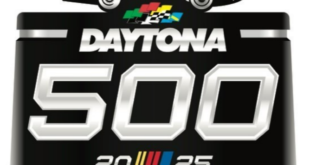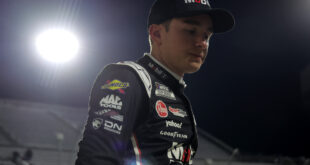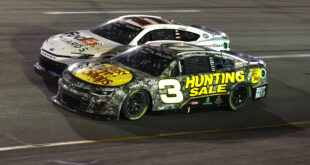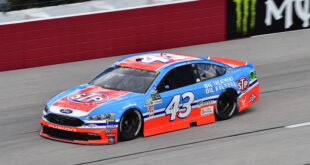Another year has come, and it’s another trip to South Carolina to honor where the sport started, with the teams and drivers attempting to move the sport forward. It’s consistently been a popular time among the teams, the drivers, fans and media alike since it’s stepping back in time.
It also is another year where teams either bring a paint scheme that hits all the notes of fans to make them happy, and some end up decent enough to be considered strong. Others, they possibly missed the mark because time was running short, and maybe some literally just don’t even bring a throwback, like the kid that doesn’t bring a snack to share for the entire class.
Now entering it’s 11th year hosting the throwback weekend for NASCAR, Darlington now in a sense is facing a slight predicament. It’s not the track itself, but teams are now at a point where trying to find a scheme to run on their cars that has not been done is challenging.
After a decade of being the host of a popular event, just exactly what can teams do that has not happened yet, especially when there’s over three dozen cars that can make the race each week.
It gets more challenging now since the official “Throwback Weekend” for NASCAR is now the first race at Darlington, and no longer during Labor Day weekend like it was for so many years. That leaves less time for teams to decide on a scheme, and less time for the graphic artists to design the wrap to put on each car.
Now that the Darlington weekend is in April and not May, that is four less weeks to even consider a scheme or idea. It’s to the point where the moment the current season ends, someone at every team is possibly looking at Darlington, looking at the sponsors that are coming in or staying, deciding on schemes to do.
So, what schemes could teams now do for every car number on the track that has not been done yet? It’s time to reach in the vault and see what is available for a few of the drivers, and their sponsors.. NOTE-Based on current drivers, numbers, and possible sponsor tie-in.
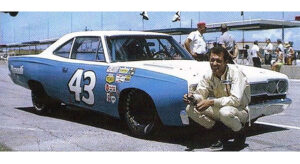 Erik Jones-No. 43 Camry
Erik Jones-No. 43 Camry
Richard Petty’s White-Top Charger
Long before the STP sponsorship and the debate on how the car should look, with the iconic Petty blue and the day-glow red, there was a time when the King experimented to an extent with a two-tone look. In 1968, for the Daytona 500, the No. 43 had a black vinyl top, much like the Plymouth Road Runner and Dodge Charger had on the production line. The hope was to gain an aero advantage, feeling the uneven surface would disrupt the air enough to discourage drafting followers, while also distracting officials during inspection.
In the end, the top began peeling away like the skin on an orange, and his quest to win the big event was done.
The vinyl top was long gone by the time the summer event at Daytona came about, but Petty’s car was not the all-blue everyone had been used to. In the hopes of trying to keep the driver cooler in the Florida heat, the team kept the sides blue, but from the lower window to the roof was painted a bright white.
We have seen the STP schemes in multiple ways with the No. 43 during throwback weekend, including this year’s as an ode to John Andretti. Unfortunately, the main difference is with no STP sponsorship, the “day-glo” red is not the same as it was on the original car.
So, why not honor the first time Petty ran a two-tone car, not because of sponsorship, but because the hope was to not have the King sweat as much in the Daytona sun.
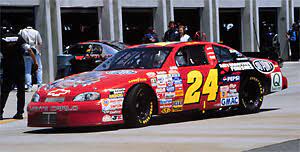 William Byron-No. 24 Chevrolet
William Byron-No. 24 Chevrolet
The T-Rex Dominance
It’s surprising that this scheme has not been run yet, possibly because of the copyright with the movie, but it’s hard to not think about the No. 24 without thinking of three schemes. The first was the rainbow, then the flames, but when it came to one-off paint schemes, the T-Rex car seems to be at the top of the list.
A car that ran one race, won that race, and then was banned. Sure, it returned for a single points-paying event that summer, but it did not have the same setup and had to be modified to the current rules.
Still, a car that in the form it was developed to have a perfect average is not heard of any longer. In todays era, cars seem to be made specifically for certain track styles, or configurations. To have a car be victorious every time it’s ran, that is not happening.
So, to honor a machine that literally was outclassing the field, had teams peeking in to see what is different, and yet was still within the rule book at the time, is quite an accomplishment.
Would be appropriate to see the No. 24 run this one final time.
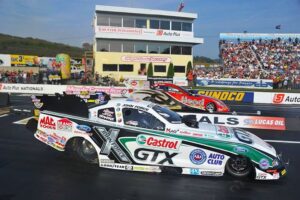 Brad Keselowski-No. 6 Mustang
Brad Keselowski-No. 6 Mustang
John Force’s Castrol Funny Car
Sometimes you have to look outside the four corners to actually do a throwback scheme, and in the case of RFK Racing, sponsorship certainly makes this an easy choice.
Last year, Castrol made it onto the car with the team to honor a road-race icon, and it led to victory.
But, when one thinks of the Castrol sponsorship, it’s not NASCAR that it’s famous for. The Valvoline and Quaker State names seem to get the attention and the schemes. One thinks Quaker State, you usually think of Jeff Gordon and Hendrick Motorsports. Valvoline has long been associated with Mark Martin, and the Havoline name is a constant reminder of Davey Allison and Ernie Irvan, even up to Ricky Rudd.
Castrol, not so much. But, in NHRA, Castrol was long remembered alongside one name…John Force.
It may not be the same sport, but the iconic castrol white, red, green and black would look excellent on the No. 6 Mustang, since Force long ran the same body style before he switched over to Chevrolet.
Force ran a tribute to Jeff Gordon when the 4-time champion announced he was hanging it up from full-time action, and with Force seemingly not getting back in the funny car at any time since his hard accident a year ago, maybe it is the right thing to do and honor an icon with his iconic partner.
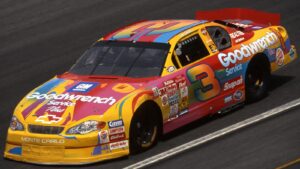 Austin Dillon-No. 3 Chevrolet
Austin Dillon-No. 3 Chevrolet
The Peter Max Car
Over the years, the team at Richard Childress Racing has brought back a lot of the iconic paint schemes over the years for the No. 3. From seeing the Wrangler colors back on the car, to the “silver surprise”, to going back in time with original Childress schemes, the No. 3 has seen some one-off paint schemes in it’s time that certainly bring back memories.
Maybe the one that some want to forget, is also one that perhaps in today’s times could be looked at differently.
Everyone remembers when Earnhardt and team revealed the scheme for both weeks at Charlotte in 2000. No black, no silver, no white number; the car was a rainbow splashed Monte Carlo that even Earnhardt could be seen going, “Wow.” Although he didn’t wear the matching fire suit, the car certainly was seen on the track, both in daylight and under the lights.
It’s a paint scheme that no one ever thought would work, but it certainly is remembered.
In today’s era, maybe the crazy scheme would be accepted. There’s no question it would get a lot of on-track attention.
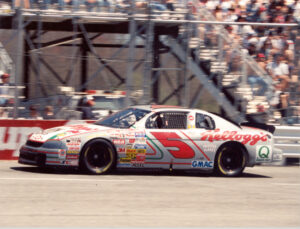 Kyle Larson-No. 5 Chevrolet
Kyle Larson-No. 5 Chevrolet
NASCAR’s Ironman
When it was originally done, the term “Ironman” was coined as someone who consistently showed up at their job, day after day, without fail. In NASCAR, in the mid-1990’s, that man was Terry Labonte, and in 1996 he would become at that time the record holder for most consecutive Cup Series starts, surpassing Richard Petty. To mark the moment he tied the record, the usual red-and-yellow Kellogg’s Monte Carlo still had hints of red and green. However, the main color on the car went to silver, and in the sun at North Wilkesboro, it shined like jewelry.
Labonte would go on and win that race, and would run the scheme once more the following week to mark him eclipsing the record. Although he ran another “Ironman” scheme a few years later, a look with the paint seemingly ripping off to expose the metal underneath, to mark his 600th-consecutive start, the original look of the car is as iconic as his Kellogg’s car.
Last year, Kyle Larson ran the familiar Labonte look at Darlington, and this year is doing an ode to Tony The Tiger, who was on Labonte’s car for his final career win, coming at the same track.
With how much Larson races, and the entirely different cars he does it in, he is seemingly NASCAR’s newest, yet slightly different, iron man. It would be fitting if that car would come back for Larson and Labonte. It took many years before the No. 5 ran the Kellogg’s colors once again, so not waiting as long for another memorable look is going to be a big advantage for old-school fans.
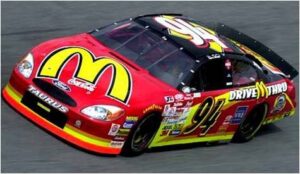
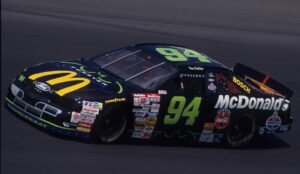 Bubba Wallace and Tyler Reddick-No. 23 & 45 Camrys
Bubba Wallace and Tyler Reddick-No. 23 & 45 Camrys
Bill Elliott’s Thunderbird and Thunderbat
Having a sponsor as iconic as the “Golden Arches” of McDonald’s one would think would be easy to find a way to honor the past schemes of years gone by. But, the reality is that not very many schemes have gone away from the red and yellow colors.
Jamie McMurray had a couple schemes that many remembered for years, running the Mac Tonight scheme in 2016, then his Donnie Allison tribute that McDonald’s allowed one year later, and then the golden anniversary Big Mac scheme in 2018.
But, when one team shares a sponsor, it could work, especially when both schemes come from a driver who ran his own team, and had that major sponsor.
Between 1995 and 2000, Bill Elliott ran the McDonald’s colors proudly, and aside from the primary red colors, he did have a few different looks on the track. In 1999, the font on the number changed, and more black got added to the car. Yet, fans still knew it was him on the track because of that Big letter on the hood. Then, for two races in 1995, the car went to Gotham City, turning black, green, and blue, with Batman turning his Ford into a Thunderbat.
With the loss of Val Kilmer, who portrayed the caped crusader in Batman Forever that Elliott helped promote, it would be a chance to honor a couple schemes that McDonald’s has yet to run on the track for Darlington. Ba Da Ba Ba Ba…the fans would be loving it.
NASCAR’s Throwback Weekend still has a lot of meaning, and it’s consistently been popular among everyone involved. It just now is harder to see what teams decide to do to honor the past, especially with less time to decide. Consider these just suggestions as to what to do for 2026 and beyond.
Anything is possible, especially in this sport.
 All About Horse Power Motorsports 24/7
All About Horse Power Motorsports 24/7
